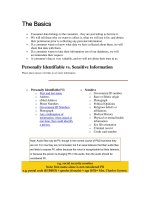Tài liệu Interpreting Terminology docx
Bạn đang xem bản rút gọn của tài liệu. Xem và tải ngay bản đầy đủ của tài liệu tại đây (102.76 KB, 5 trang )
CHAPTER 2
Interpreting Terminology
CHAPTER 2
Interpreting Terminology
Technical terms used throughout this guide are defined
and explained below. Terms are not presented alphabetically.
They are arranged in an order that is more suitable for readers
to learn the fundamentals of interpreting concepts,
terminology, and procedure.
Non-English speaking
person
“Non-English speaking person” is the term used in the
text to refer to any person who is unable to communicate in
English or who has a limited ability to communicate in
English. The term also applies when the language limitation
arises due to deafness or being hard of hearing. The term
generally refers to a principal party in interest or a witness in
the case.
Source language
Source language is the language of the original speaker.
"Source language" is thus always a relative term, depending on
who has spoken last.
Target language is the language of the listener, the
language into which the interpreter is communicating the
meaning of the words spoken in the source language.
Target language
Interpretation means the unrehearsed transmitting of a
spoken or signed message from one language to another.
Interpretation is distinguished from "translation," which
relates to written language (see below). Two modes of
interpreting are used in court by qualified interpreters --
"simultaneous" and "consecutive." A third common mode is
Interpretation
31
Court Interpretation: Model Guides for Policy and Practice in the State Courts
"summary" interpreting, which should not be used in court
settings. These terms are also defined below.
Consecutive interpreting is rendering statements made
in a source language into statements in the target language
intermittently after a pause between each completed statement
in the source language. In other words, the interpreter renders
an interpretation after the speaker has stopped speaking.
Consecutive interpreting
When using this mode of interpreting, it may be
necessary for the interpreter to signal a speaker to pause to
permit a consecutive interpretation when the length of the
utterance approaches the outer limits of the interpreter's
capacity for recall. During consecutive interpreting, the
interpreter should take notes to assist him/her in rendering the
interpretation.
Simultaneous interpreting is rendering an
interpretation continuously at the same time someone is
speaking. Simultaneous interpreting is intended to be heard
only by the person receiving the interpretation and is usually
accomplished by speaking in whispered tones or using
equipment specially designed for the purpose in order to be as
unobtrusive as possible.
Simultaneous
interpreting
Sight interpreting is more commonly referred to as
"sight translation" (see below).
Sight interpreting
Summary interpreting
Summary interpreting is paraphrasing and condensing
the speaker's statement. Unlike simultaneous and consecutive
interpreting, this method does not provide a precise rendering
of everything that is said into the target language. This is a
mode of interpreting that should not be used in court settings.
32
Interpreting Terminology
33
Intermediary interpreting involves more than one
interpreter to reach people who have idiosyncratic speech
characteristics or (in the case of deaf people) who employ
gestures or other signing varieties beyond the understanding of
the primary interpreter. Intermediary interpreting should be
undertaken with a trained primary interpreter, assisted by the
secondary interpreter. Secondary interpreters may be deaf
people holding the Reverse Skills Certificate (RSC) awarded by
the National Registry of Interpreters for the Deaf, family
members or friends of the person needing special
communicative assistance, and professional service providers.
See Chapter 7 for more information about when relay
interpreters are needed.
Intermediary or "relay"
interpreting
Intermediary interpreters must work with a primary
interpreter who is a professional.
Translation is converting a written text from one
language into written text in another language. The source of
the message being converted is always a written language.
Translation
Sight translation is a hybrid type of
interpreting/translating whereby the interpreter reads a
document written in one language while translating it orally
into another language. It is sometimes called sight
interpreting. In this mode of interpreting a written text must
be rendered orally without advance notice and on sight.
Sight translation
Functions of interpreting relate to the purpose or the
setting in which interpreting occurs. It is important to
understand the functions of interpreting because in some
settings more than one interpreter will be required, depending
on how many interpreting functions need to be carried out
during the same proceeding.
Interpreting functions
Court Interpretation: Model Guides for Policy and Practice in the State Courts
In some circumstances, two or more interpreters might
be required during one trial in order to perform all of the
required interpreting functions.
Proceedings interpretation is for a non-English speaking
litigant in order to make the litigant "present" and able to
participate effectively during the proceeding. This interpreting
function is ordinarily performed in the simultaneous mode.
The interpreter’s speech is always in the foreign language, and
is not part of the record of proceedings.
Proceedings
interpreting
Witness interpreting
Witness interpretation is interpretation during witness
testimony for the purpose of presenting evidence to the court.
This interpreting function is performed in the consecutive
mode; the English language portions of the interpretation are
part of the record of the proceeding. A variant of “witness”
interpreting is assistance provided by the interpreter during
communications between the judge or other English-speaking
official on the case and a non-English-speaking defendant or
civil litigant. Typical examples are communications who occur
during arraignments, plea or sentencing hearings.
Interview interpreting
Interview interpreting is interpreting to facilitate
communication in interview or consultation settings. Interview
interpreting may occur in conjunction with court proceedings or
before or after court proceedings. Foremost among these are
interviews or consultations that take place between attorney
and client (sometimes referred to as "defense" interpreting) and
between a non-English speaking person and bail screening or
probation personnel.
Interview interpreting may be performed in either or
both the simultaneous and consecutive modes during an
interview, depending on the circumstances.
34









